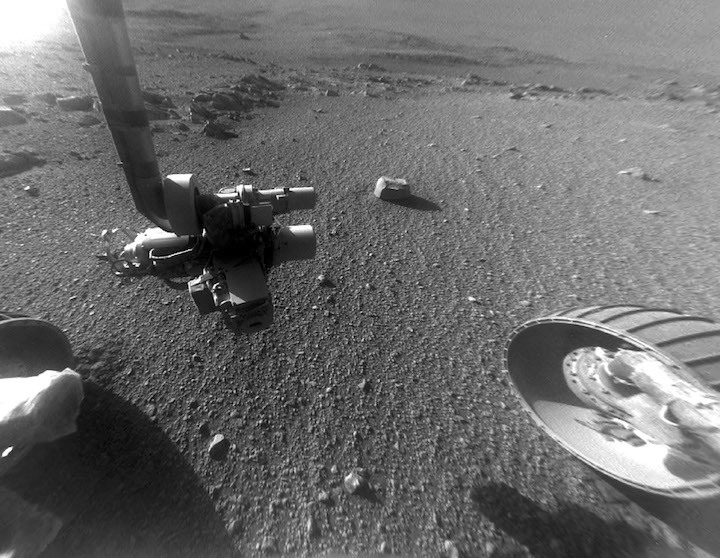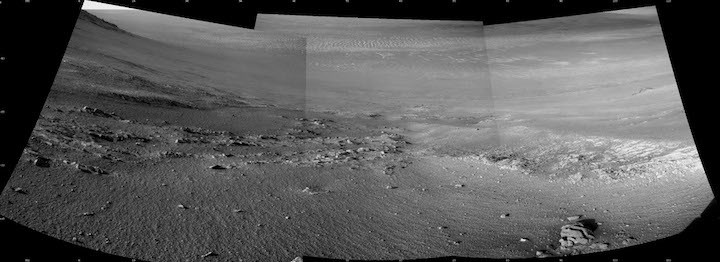16.02.2018

The Sun will rise on NASA's solar-powered Mars rover Opportunity for the 5,000th time on Saturday, sending rays of energy to a golf-cart-size robotic field geologist that continues to provide revelations about the Red Planet.
"Five thousand sols after the start of our 90-sol mission, this amazing rover is still showing us surprises on Mars," said Opportunity Project Manager John Callas, of NASA's Jet Propulsion Laboratory, Pasadena, California.
A Martian "sol" lasts about 40 minutes longer than an Earth day, and a Martian year lasts nearly two Earth years. Opportunity's Sol 1 was landing day, Jan. 25, 2004 (that's in Universal Time; it was Jan. 24 in California). The prime mission was planned to last 90 sols. NASA did not expect the rover to survive through a Martian winter. Sol 5,000 will begin early Friday, Universal Time, with the 4,999th dawn a few hours later. Opportunity has worked actively right through the lowest-energy months of its eighth Martian winter.
From the rover's perspective on the inside slope of the western rim of Endeavour Crater, the milestone sunrise will appear over the basin's eastern rim, about 14 miles (22 kilometers) away. Opportunity has driven over 28 miles (45 kilometers) from its landing site to its current location about one-third of the way down "Perseverance Valley," a shallow channel incised from the rim's crest of the crater's floor. The rover has returned about 225,000 images, all promptly made public online.
"We've reached lots of milestones, and this is one more," Callas said, "but more important than the numbers are the exploration and the scientific discoveries."
The mission made headlines during its first months with the evidence about groundwater and surface water environments on ancient Mars. Opportunity trekked to increasingly larger craters to look deeper into Mars and father back into Martian history, reaching Endeavour Crater in 2011. Researchers are now using the rover to investigate the processes that shaped Perseverance Valley.
Quelle: NASA
+++
Long-Lived Mars Rover Opportunity Keeps Finding Surprises

This image shows stone stripes on the side of a volcanic cone on Mauna Kea, Hawaii. The stripes are made of small rock fragments and they are aligned downhill as freeze-thaw cycles have lifted them up and out of the finer-grained regolith, and moved them to the sides, forming stone stripes.
This site is at about 13,450-foot (4,100-meter) altitude on the mountain. For scale, the rock cluster toward the bottom right of the image is approximately 1 foot (30 centimeters) wide. The image was taken in 1999 by R. E. Arvidson.
Such ground texture has been seen in recent images from NASA's Mars Exploration Rover Opportunity.

This late-afternoon view from the front Hazard Avoidance Camera on NASA's Mars Exploration Rover Opportunity shows a pattern of rock stripes on the ground, a surprise to scientists on the rover team. Approaching the 5,000th Martian day or sol, of what was planned as a 90-sol mission, Opportunity is still providing new discoveries.
This image was taken inside "Perseverance Valley," on the inboard slope of the western rim of Endeavour Crater, on Sol 4958 (Jan. 4, 2018). Both this view and one taken the same sol by the rover's Navigation Camera look downhill toward the northeast from about one-third of the way down the valley, which extends about the length of two football fields from the crest of the rim toward the crater floor.
The lighting, with the Sun at a low angle, emphasizes the ground texture, shaped into stripes defined by rock fragments. The stripes are aligned with the downhill direction. The rock to the upper right of the rover's robotic arm is about 2 inches (5 centimeters) wide and about 3 feet (1 meter) from the centerline of the rover's two front wheels.
This striped pattern resembles features seen on Earth, including on Hawaii's Mauna Kea, that are formed by cycles of freezing and thawing of ground moistened by melting ice or snow. There, fine-grained fraction of the soil expands as it freezes, and this lifts the rock fragments up and to the sides. If such a process formed this pattern in Perseverance Valley, those conditions might have been present locally during a period within the past few million years when Mars' spin axis was at a greater tilt than it is now, and some of the water ice now at the poles was redistributed to lower latitudes. Other hypotheses for how these features formed are also under consideration, including high-velocity slope winds.
NASA's Jet Propulsion Laboratory, a division of the California Institute of Technology in Pasadena, manages the Mars Exploration Rover Project for NASA's Science Mission Directorate, Washington.

Textured rows on the ground in this portion of "Perseverance Valley" are under investigation by NASA's Mars Exploration Rover Opportunity, which used its Navigation Camera (Navcam) to take the component images of this downhill-looking scene.
The rover took this image on Jan. 4, 2018, during the 4,958th Martian day, or sol, of its work on Mars, looking downhill from a position about one-third of the way down the valley. Perseverance Valley descends the inboard slope of the western rim of Endeavour Crater. A view on the same sol with the rover's front Hazard Avoidance Camera includes ground even closer to the rover at this site. Opportunity was still working close by as it reached the mission's Sol 5,000 (Feb. 16, 2018).
In the portion of the valley seen here, soil and gravel have been shaped into a striped pattern in the foreground and partially bury outcrops visible in the midfield. The long dimensions of the stripes are approximately aligned with the downhill direction. The striped pattern resembles a type of feature on Earth (such as on Hawaii's Mauna Kea) that is caused by repeated cycles of freezing and thawing, though other possible origins are also under consideration for the pattern in Perseverance Valley.
The view is spans from north on the left to east-southeast on the right. For scale, the foreground rock clump in the lower right is about 11 inches (28 centimeters) in width.
-
NASA's Mars Exploration Rover Opportunity keeps providing surprises about the Red Planet, most recently with observations of possible "rock stripes."
The ground texture seen in recent images from the rover resembles a smudged version of very distinctive stone stripes on some mountain slopes on Earth that result from repeated cycles of freezing and thawing of wet soil. But it might also be due to wind, downhill transport, other processes or a combination.
Opportunity landed on Mars in January 2004. As it reaches the 5,000th Martian day, or sol, of what was planned as a 90-sol mission, it is investigating a channel called "Perseverance Valley," which descends the inboard slope of the western rim of Endeavour Crater.

"Perseverance Valley is a special place, like having a new mission again after all these years," said Opportunity Deputy Principal Investigator Ray Arvidson of Washington University in St. Louis. "We already knew it was unlike any place any Mars rover has seen before, even if we don't yet know how it formed, and now we're seeing surfaces that look like stone stripes. It's mysterious. It's exciting. I think the set of observations we'll get will enable us to understand it."
On some slopes within the valley, the soil and gravel particles appear to have become organized into narrow rows or corrugations, parallel to the slope, alternating between rows with more gravel and rows with less.
The origin of the whole valley is uncertain. Rover-team scientists are analyzing various clues that suggest actions of water, wind or ice. They are also considering a range of possible explanations for the stripes, and remain uncertain about whether this texture results from processes of relatively modern Mars or a much older Mars.
Other lines of evidence have convinced Mars experts that, on a scale of hundreds of thousands of years, Mars goes through cycles when the tilt or obliquity of its axis increases so much that some of the water now frozen at the poles vaporizes into the atmosphere and then becomes snow or frost accumulating nearer the equator.
"One possible explanation of these stripes is that they are relics from a time of greater obliquity when snow packs on the rim seasonally melted enough to moisten the soil, and then freeze-thaw cycles organized the small rocks into stripes," Arvidson said. "Gravitational downhill movement may be diffusing them so they don't look as crisp as when they were fresh."
Bernard Hallet of the University of Washington, Seattle, agrees the alignments seen in images of Perseverance Valley are not as distinctive as the stone stripes he has studied on Earth. Field measurements on Earth, near the summit of Hawaii's Mauna Kea where the soil freezes every night but is often dry, have documented how those form when temperature and ground conditions are right: Soils with a mix of silt, sand and gravel expand more where the finer-grain material is most prevalent and retains more water. Freezing expands the soil, pushing larger particles up. If they move to the side, as well as down the general slope, due to gravity or wind, they tend to move away from the finer-grain concentrations and stretch out downslope. Where larger particles become more concentrated, the ground expands less. The process repeats hundreds or thousands of times, and the pattern self-organizes into alternating stripes.
Perseverance Valley holds rocks carved by sand blowing uphill from the crater floor, and wind might also be the key in sorting larger particles into rows parallel to the slope.
"Debris from relatively fresh impact craters is scattered over the surface of the area, complicating assessment of effects of wind," said Opportunity science-team member Robert Sullivan of Cornell University, Ithaca, New York. "I don't know what these stripes are, and I don't think anyone else knows for sure what they are, so we're entertaining multiple hypotheses and gathering more data to figure it out."
Quelle: NASA
